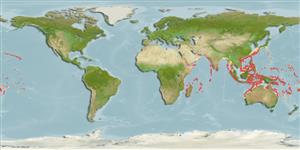Actinopterygii (ray-finned fishes) >
Perciformes (Perch-likes) >
Lutjanidae (Snappers) > Etelinae
Etymology: Aphareus: Greek, aphareys, -eos = water wings under the belly of female tunna (Ref. 45335). More on author: Cuvier.
Environment / Climate / Range
Ecology
Marine; reef-associated; depth range 100 - 330 m (Ref. 37816). Tropical, preferred 27°C (Ref. 107945); 35°N - 28°S, 38°E - 150°W (Ref. 55)
Indo-Pacific: East Africa to the Hawaiian Islands, north to the Ryukyu and Ogasawara islands, south to Australia. Southeast Atlantic: Port Alfred, South Africa (Ref. 11228).
Size / Weight / Age
Maturity: Lm ? range ? - ? cm
Max length : 110 cm TL male/unsexed; (Ref. 5484); common length : 79.0 cm SL male/unsexed; (Ref. 37816); max. published weight: 11.3 kg (Ref. 4887)
Dorsal
spines
(total): 10;
Dorsal
soft rays
(total): 10-11;
Anal
spines: 3;
Anal
soft rays: 8. Maxilla extending to below middle of eye; interorbital space flattened. Dorsal and anal fins without scales. Generally blue-gray or mauve to overall reddish; fins yellowish to reddish except pelvic and anal fins which are sometimes whitish; margin of maxilla black.
Adults inhabit reefs and rocky bottom areas to depths of at least 100 m (Ref. 4887). Pelagic and benthopelagic (Ref. 58302). Feed on fishes, squids and crustaceans (Ref. 4887). Marketed fresh (Ref. 37816).
Life cycle and mating behavior
Maturity | Reproduction | Spawning | Eggs | Fecundity | Larvae
Allen, G.R., 1985. FAO Species Catalogue. Vol. 6. Snappers of the world. An annotated and illustrated catalogue of lutjanid species known to date. FAO Fish. Synop. 125(6):208 p. Rome: FAO. (Ref. 55)
IUCN Red List Status (Ref. 115185)
CITES (Ref. 94142)
Not Evaluated
Threat to humans
Harmless
Human uses
Fisheries: commercial; gamefish: yes
More information
ReferencesAquacultureAquaculture profileStrainsGeneticsAllele frequenciesHeritabilityDiseasesProcessingMass conversion
Tools
Special reports
Download XML
Internet sources
